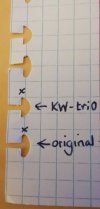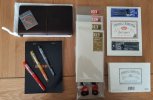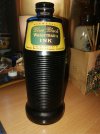View attachment 70246
Waterman vintage ink.
Provenance - It was rescued from the store cupboard of a primary school in North Lanarkshire that was being demolished in the mid-nineties. It ended up in an artefact collection that my partner curated. She saved it from a skip when the council shut the service down. It was new and unopened until last week - the rubber seal was intact and not perished.
Dating - This was surprisingly hard - given the vastness of t'interweb but initially the best clues were the label and bottle. I could find very little hard and fast information - if anyone knows better I'd be delighted to hear from them. This size was primarily supplied to educational users - it would have sat on the teacher's desk and been used to fill up the inkwells in the desks of pupils. Initially I discovered, due to the style of label and the bottle design - art deco - it cannot be later than the early 50's - Waterman changed all their packaging at this point. What is also unusual is that it was made in England - the vast majority of Waterman ink was made in the USA or Canada - but the reason for this becomes more obvious later. Upon further examination of the bottle I found a code on the underside that indicates that it was packaged in January 1940! It is probably around 81 years old. The empty bottles - due to the deco design - change hands around $100 - people make lamps out of them for a period look.
Usability - We opened it and did a swab test - it is in perfect condition - no mould and no separation. The shading is amazing compared to modern ink but the clue is in the description 'permanent' on the label. It is iron gall ink - and indeed it is permanent - I ran water over a sample when it was dry and nothing shifted - no run, no smudging. The down side of this - as to writing with it - is that ink of this type is - relatively - very acidic, so will corrode a modern pen from the inside out. A gold or rhodium nib won't be affected but the ink supply mechanism won't be made from these materials. The ink looks just blue when wet but if you leave it 24 hours it starts to oxidise and it darkens considerably - a proper blue/black.
@Blademonkey and myself were thinking it might be quite cool to write with it - that is after all what ink is for - the best solution might be to get a couple of cheap Chinese fountain pens and it doesn't really matter if the ink ruins them. We'll take one for the team and see what happens.
I though this was a nice find - it is remarkable it has survived this long - yours - I.




